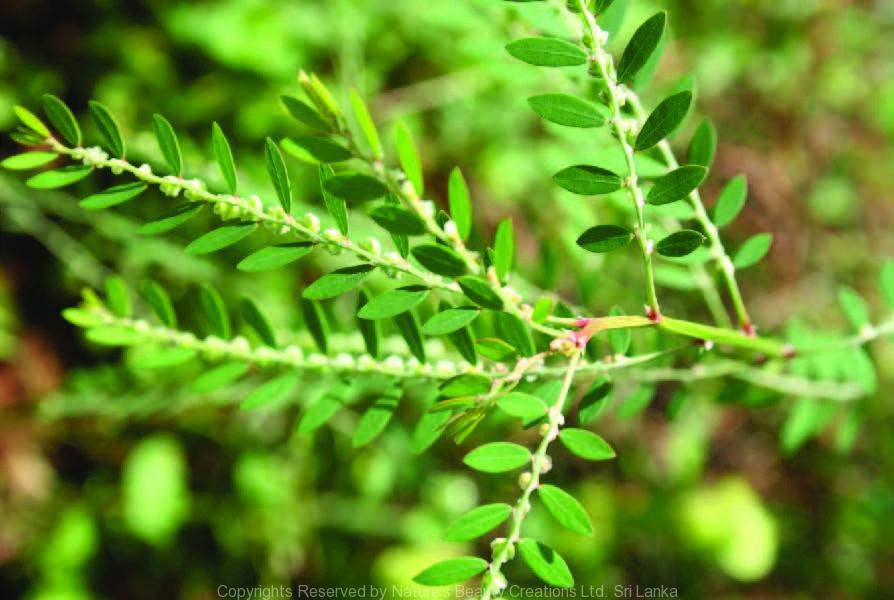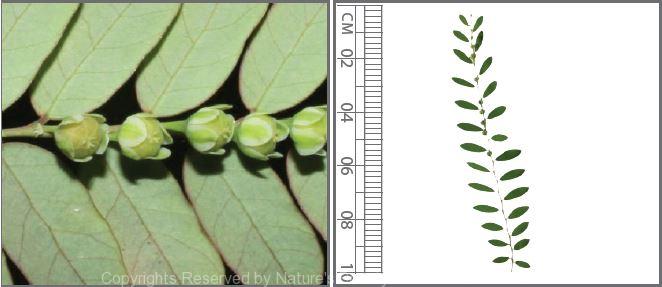

Traditional Knowledge
Useful plant parts :
Whole plant
Uses in traditional medicine :
- Herbal soup prepared with the whole plant is mixed with rice and given for yellow fever
Scientific Research
Chemical constituents:
Tannins: phyllanthusiin D, geraniin, amariin, corilagin, amarulone, alkaloids: isobubbialine, epibubbialine, phyllanthine, securinine and norsecurinine from plant
Bioactivity :
Aqueous, alcohol and hexane extracts of plant: anti-inflammatory, free radical scavenger, inhibit hepatocarcinogenesis, HIV inhibitor, antidiabetic and α-amylase inhibitor; aqueous extract of aerial parts: anticancer, effective in treating hepatitis B; tannins: radioprotective; aqueous extract of seeds and leaves: control insulin resistance
Clinical:
A preparation of whole plant is a potential diuretic, hypotensive and hypoglycaemic drug
References : Adeneye, A. A., (2012), The leaf and seed aqueous extract of Phyllanthus amarus improves insulin resistance diabetes in experimental animal studies, J Ethnopharmacol, 144(3), 705-11 Foo, L. Y. and Wong, H., (1992), Phyllanthusiin D, an unusual hydrolys- able tannin from Phyllanthus amarus, Phytochemistry, 31(2), 711-713. Foo, L. Y. et al., (1993), Amarulone, a Novel Cyclic Hydrolysable Tannin from Phyllanthus amarus, Natural Product Letters, 3(1), 45-52. Houghton, P. J., (1996), Two securinega-type alkaloids from Phyllanthus amarus, Phytochemistry, 43(3), 715-717.. Iniyan, G. et al., (2010), In vitro study on α-amylase inhibitory activity of an Indian medicinal plant, Phyllanthus amarus, Indian J Pharmacol, 42(5), 280–282. Jeena, K. J. et al., (1999), Effect of Emblica officinalis, Phyllanthus amarus and Picrorrhiza kurroa on N-nitrosodiethylamine induced hepatocarcino- genesis, Cancer Letters, 136(1), 11-16. Kiemer, A. K. et al., (2003), Phyllanthus amarus has anti-inflammatory potential by inhibition of iNOS, COX-2, and cytokines via the NF-κB pathway, Journal of Hepatology, 38(3), 289-297. Lim, Y. Y. and Murtijaya, J., (2007), Antioxidant properties of Phyllan- thus amarus extracts as affected by different drying methods, LWT – Food Science and Technology, 40(9), 1664-1669. Londhe, J. S, et al., (2012), Geraniin and amariin, ellagitannins from Phyllanthus amarus, protect liver cells against ethanol induced cytotoxic- ity, Fitoterapia, 83(8), 1562-8. Londhe, J. S. et al., (2009), Radioprotective properties of polyphenols from Phyllanthus amarus Linn, J Radiat Res, 50(4), 303-9. Notka, F. et al., (2004), Concerted inhibitory activities of Phyllanthus amarus on HIV replication in vitro and ex vivo, Antiviral Research, 64(2), 93-102. Patel, J. R. et al., (2011), Phyllanthus amarus: ethnomedicinal uses, phytochemistry and pharmacology: a review, J Ethnopharmacol, 138(2), 286-313. Rajeshkumar, N. V. et al., (2002), Antitumour and anticarcinogenic activity of Phyllanthus amarus extract, J Ethnopharmacol, 81(1), 17-22. Srividya, N. and Periwal, S., (1995), Diuretic, hypotensive and hypogly- caemic effect of Phyllanthus amarus, Indian J Exp Biol, 33(11), 861-4. Thyagarajan, S. P. et al., (1988), Effect of Phyllanthus amarus on chronic carriers of hepatitis B virus, The Lancet, 332(8614) , 764–766.
Copyrights Reserved By
Natures Beauty Creations



